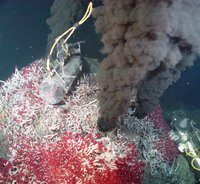
Completed late in 2014, this submarine network now enables real-time, high-bandwidth, 2-way communication with seafloor/water-column sensor-robotic arrays, across: 1. the Cascadia accretionary prism, 2. the JdF spreading center, and, 3. portions of the overlying NE Pacific Ocean. On April 24, 2015, we were able to remotely track the onset and evolution of a Mid Ocean Ridge volcanic eruption, 400 km offshore, without being there. Follow-up mapping and sampling of the products allow novel insights into the functioning of submarine volcano-hydrothermal systems. These events signal a new era in Ocean Sciences as instantaneous Internet access to events far offshore in both normal oceanic environments, and in more exotic ‘extreme’ environments, allow interactive responses to complex processes unfolding within these difficult-to-study systems. A wide range of novel experimental opportunities now emerge for studying both chemosynthetically and photosynthetically driven marine ecosystems utilizing a spectrum of sustained, real-time, remote, ‘natural laboratories’.
 Getting Under Europa’s Skin
Getting Under Europa’s Skin Tracing Formation and Evolution of Outer Solar System Bodies Through Stable Isotopes and Noble Gas Abundances
Tracing Formation and Evolution of Outer Solar System Bodies Through Stable Isotopes and Noble Gas Abundances Photosynthesis, a Planetary Revolution
Photosynthesis, a Planetary Revolution Xenon: King of the Gases
Xenon: King of the Gases